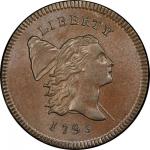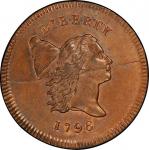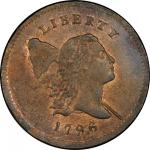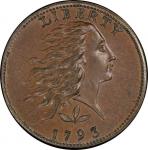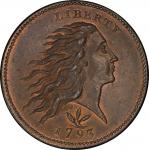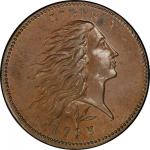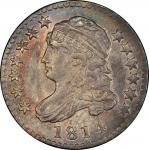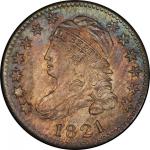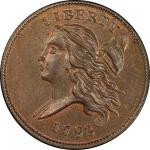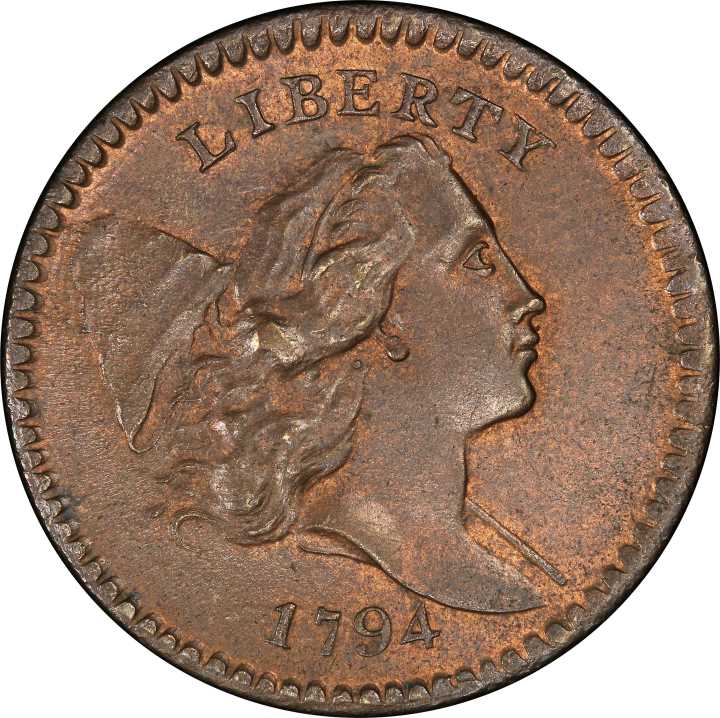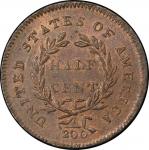“The importance of the 1794-1795 coins from the William Strickland – Charles Winn – Lord St. Oswald – Nostell Priory Collection cannot be understated.” — David Tripp If all prospective bidders knew about this coin was its provenance, they would have all necessary information to imagine this coin’s originality, eye appeal, and overall quality. Obtained by William Strickland in Philadelphia between December 12, 1794, and July 29, 1795, it has changed little since that time. The surfaces have gently mellowed from full mint red, but without losing an iota of the cartwheel luster that remains bold on both sides. The obverse patina appears at arm’s length to be chocolate brown with mint red highlights around peripheries and design elements, but closer examination reveals an integrated and appealing blend of brown and red. The reverse offers a similar look, though the surfaces appear to be even redder as the cartwheel passes any particular area. Both surfaces exhibit a sedate originality, fresh and highly lustrous, but without any sort of brightness, just the sort of appearance one would expect of a coin that has been barely handled over the course of over 200 years. The planchet is unflawed, and the strike is bold enough to obliterate all significant pre-striking marks and texture. A single tiny contact point is noted near the corner of Liberty’s eye, and a similarly inconsequential mark is present inside the top of the wreath above L of HALF. A nearly invisible hairline crosses Liberty’s cheek, barely reaching the corner of her nose. Two tiny specks of surface detritus rest between the leaves at the opening atop the reverse wreath. The die state is advanced, equivalent to Breen’s state IV and Manley’s state 3.0, with a substantial crack from the rim through Liberty’s cap and a lighter crack connecting the tops of IBERTY. Traces of die clashing are seen around the central obverse device, particularly prominent behind Liberty’s head, at the lower curls, and near Liberty’s lips. The obverse appears fatigued and flowlined around Liberty’s cap, with some lapping lines crossing the central obverse below the centering dot. On the reverse, the raised horizontal artifacts above NT of CENT and across the wreath into the area of ERIC are likely remnants of a lapping process to rid the die of vestiges of clashing, an act that likely helped weaken the bases of HA and the tops of CE, which are never fully struck, softening as the die weakens over time. Most students of the series consider this the finest known 1794 Cohen-9. The Missouri Cabinet coin was graded MS-65 RB (PCGS). The PCGS MS-66 BN McGuigan specimen surpasses the Missouri Cabinet piece in terms of certified grade; in coin-to-coin comparison with the Missouri Cabinet coin at the 2007 Early American Coppers Half Cent Happening, the McGuigan coin also received top honors. The Pogue coin was not present, but its combination of technical excellence and mint color make it a strong candidate for finest known honors. When the Breen/Hanson census was composed, this piece was still secreted away in Yorkshire; it was unknown to American half cent collectors until 1992 and even today has not been seen by most half cent enthusiasts. On the Breen/Hanson census, both the second and third listings represent a single coin, now known as the Missouri Cabinet specimen. The first listing on the same census is based upon a one-line description in an unplated 1960 sale catalog, but considering the price realized of $325, it was probably not of top calibre and would probably be considered About Uncirculated today. Another high grade 1794 Cohen-9 is impounded in the British Museum, graded by most observers at the lower ranks of Mint State and now lacking any mint color. A debate to determine which is more spectacular, this coin’s quality or its provenance, would find no satisfying conclusion. As with the other coins of this date that bear the Lord St. Oswald name, the quality and provenance is inseparable. Unlike most of the coins gathered during William Strickland’s 10-month sojourn in the United States in 1794 and 1795, this coin was not sold in the October 1964 Christie’s sale that made “Lord St. Oswald” the most desirable provenance in American numismatics. This coin remained with the Winn family, reposing within the splendid Chippendale coin and medal cabinet at Nostell Priory until it was sold by Christie’s in February 1992, beneath an unprepossessing headline that read “The Property of a Gentleman / Coins removed from Nostell Priory, Wakefield, Yorkshire” in an otherwise unremarkable 513-lot London coin auction. This half cent was joined by a high grade but not quite Uncirculated 1794 Sheldon-30 cent, a similar 1794 Sheldon-57 cent, another 1794 half cent from the same dies as this, and a slightly circulated 1793 Chain cent, a piece that has every appearance of having been plucked out of American circulation a couple years after its issuance. The auction also dispersed a small collection of pre-Federal coins from the Nostell Priory collection, coins likely acquired in America though probably not found in everyday circulation, like Massachusetts Oak and Pine Tree coins and an American Plantation token. Others from the collection were probably still commonly circulating when Strickland visited the United States, such as state coppers from Massachusetts, Connecticut, New Jersey, and Vermont; a 1794 Talbot, Allum, & Lee token; Nova Constellatio coppers of 1783 and 1785; and a 1791 Washington Small Eagle cent. This coin has the oldest known provenance of any United States half cent, an honor it shares with the other Strickland-Lord St. Oswald 1794 half cent sold in the February 1992 Christie’s sale. David Tripp’s essay in the D. Brent Pogue Collection, Part II, catalog summarizes the amazing story of William Strickland’s visit to the United States, a voyage that began in New York on September 20, 1794, and ended when he left Philadelphia on July 29, 1795. Between those dates, Strickland saw much of America, from New England to Virginia, and began long-term friendships with Thomas Jefferson and George Washington, both of whom hosted him at their Virginia plantations. A collector with typically broad Enlightenment-era curiosities, Strickland’s main purpose in visiting the United States was to study its agriculture, but he will be forever remembered by numismatists for the souvenirs he obtained here to add to his already robust cabinet of coins in Yorkshire. The finer of Strickland’s two 1794 dollars made headlines when it brought nearly $5 million in the Pogue II sale. The choice Mint State large cents he gathered during his long stay in Philadelphia remain the aristocrats of the early American copper community. His half cents, fewer in number, deserve to be held in equal esteem. This is the finer of the two half cents he brought home. It has never before been offered at public auction in its nation of origin. PCGS# 35064.

